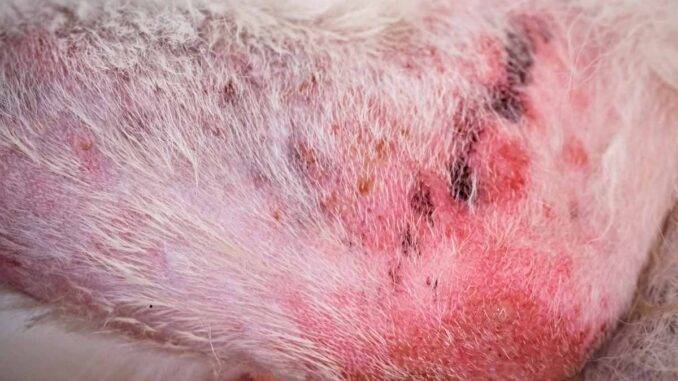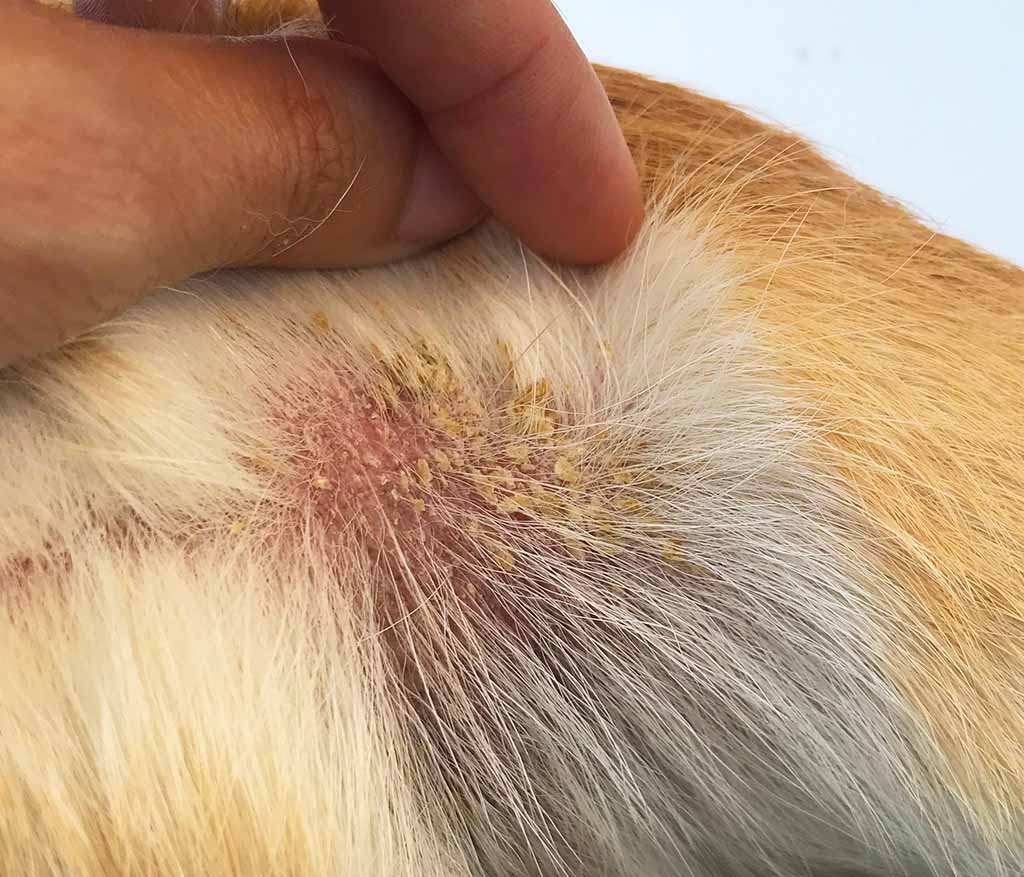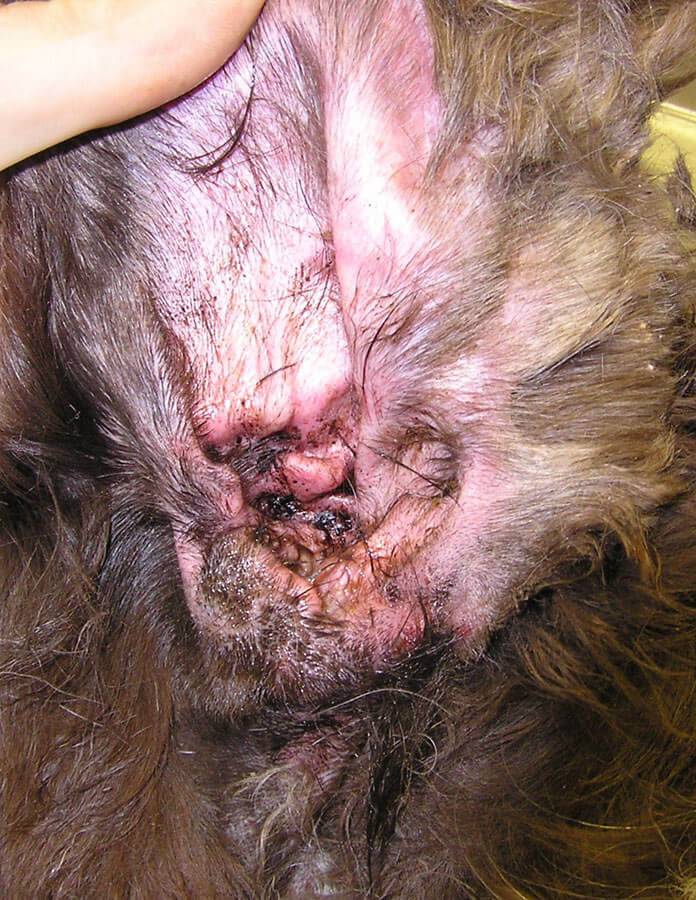Great Dane skin bumps can be a common health problem that pup owners don’t need to worry about and they can also be a warning sign for something more serious with your Gentle Giants.
With countless skin conditions, pet parents with a Great Dane may not be sure if their bumps are worth a veterinary visit. Here’s what you should know about Great Dane skin bumps and when to seek professional help.


Most of the time, skin bumps on your Great Dane are nothing to worry about and are simply a part of their normal anatomy. For example, many Great Danes have bumps on their backs due to the location of their spine. These bumps are called withers and are completely normal.
However, there are some skin bumps that can be a sign of a more serious health problem.


GREAT DANE SKIN BUMPS: WHEN TO BE CONCERNED WITH ITCHY SKIN AND WHEN IT’S OKAY
As a Great Dane owner, you may have noticed that your dog has some skin allergies or irritation from time to time. While some of these problems are nothing to worry about, others can be indicative of more serious health issues. So, when should you be concerned about your Great Dane’s skin problems? Let’s take a look.
SKIN INFECTION
One type of Great Dane skin problem that you should be concerned about is skin infections. Skin infections can be caused by bacteria, viruses, or fungi, and they often lead to redness, swelling, and itchiness. If not treated promptly, infections can spread to other parts of the body and become life-threatening. If you notice any signs of a skin infection on your dog, you can speak with your vet about the common signs of skin diseases and discuss how to strengthen their immune system.
HAIR LOSS
Another type of skin problem that can be indicative of a more serious health issue is hair loss. If your dog is losing hair in patches or their coat is thinning out overall, it could be a sign of an underlying health condition such as allergies, hormonal imbalance, or thyroid disease. If you notice hair loss on your dog, make an appointment with your vet so they can determine the cause and start treatment if necessary.
HOT SPOTS
Hot spots are another common skin problem in Great Danes (and other dogs). Hot spots are open wounds that are often painful and can become infected if not treated properly. These spots of irritation on a Great Dane’s skin are often caused by allergies or poor grooming habits.
YEAST INFECTIONS
Yeast infections are another type of skin problem that Great Danes are susceptible to. Yeast infections often cause the skin to become red and itchy and can lead to secondary bacterial infections if left untreated. If you think your dog may have a yeast infection, take them to the vet for diagnosis and treatment.
NON CONCERNING SKIN ISSUES
Not all skin problems are indicative of a more serious health issue; in fact, some are perfectly normal and nothing to worry about. For example, if you notice your dog scratching more than usual during seasonal changes or after being outside, it’s likely just an allergic reaction that will go away on its own once the allergens clear out. Similarly, if your dog licks or bites their paws frequently, they may just have dry skin or minor irritations.
FOOD ALLERGIES IN A GREAT DANE THAT CAUSE ITCHY SKIN
Food allergies are a common problem in Great Danes. They can cause itchiness and discomfort for your dog, and may even lead to secondary infections. In this blog post, we’ll discuss the clinical signs of food allergies, the secondary infections that may result from them, and how you can eliminate the allergens from your dog’s diet.
CLINICAL SIGNS OF FOOD ALLERGIES WITH YOUR GENTLE GIANT
The most common clinical sign of a food allergy in dogs is itchiness. If your dog is scratching or licking excessively, it may be due to an allergic reaction. Other signs include red or inflamed skin, hair loss, hot spots, and Ear infections. If your dog is experiencing any of these symptoms, it’s important to consult with your veterinarian so that they can perform a food allergy test.
SECONDARY INFECTIONS RELATED TO FOOD ALLERGIES
If left untreated, food allergies can lead to secondary infections. The most common infection seen in dogs with food allergies is pyoderma, which is a bacterial infection. Yeast infections are also common, as are ear infections. These infections can be painful and uncomfortable for your dog, so it’s important to get them treated as soon as possible.
YOUR GREAT DANE’S SKIN AND FOOD ALLERGIES
Great Danes are especially susceptible to food allergies because they have sensitive skin. Their skin is thin and prone to irritation, making them more likely to experience the itching and discomfort that are associated with allergies. Additionally, their large size means that they have more surface area for allergens to affect.
ELIMINATION DIET FOR HEALTHY SKIN
If your dog is diagnosed with a food allergy, the best way to manage it is through an elimination diet. This involves removing all potential allergens from your dog’s diet and slowly reintroducing them one at a time until you identify the culprit. Your veterinarian can help you select an appropriate diet for your dog and guide you through the process of eliminating potential allergens.
Food allergies are a common problem in Great Danes, but luckily there are ways to manage them! If your dog is showing signs of a food allergy, be sure to consult with your veterinarian so that they can perform a food allergy test. An elimination diet is often the best way to identify the allergen and provide relief for your dog’s itchiness and discomfort. With some patience and guidance from your vet, you can help your Great Dane live a comfortable life despite their food allergies!
BACTERIAL INFECTIONS ON GREAT DANE’S SKIN
As a great dane owner, you may be all too familiar with the never-ending battle against bacterial infections on your dog’s skin. But did you know that there are actually several different types of bacteria that can infect your dog’s skin? And that each type of bacteria requires a different treatment approach?
SECONDARY INFECTIONS
Secondary infections are the most common type of bacterial infection in large breeds and other dog breeds. They usually occur after your dog has already been treated for an underlying condition, such as allergies or insect bites. The most common symptom of a secondary skin infection is red, inflamed skin. Treatment typically involves a combination of antibiotics and anti-inflammatory drugs.
YOUR DOG’S IMMUNE SYSTEM
The second most common type of bacterial infection in dogs is an immune system disorder. immune system disorders can be caused by a number of things, including medications, allergies, and even stress. The most common symptom of an immune system disorder is recurring infections. Treatment typically involves immunotherapy or oral steroids.
MEDICATED SHAMPOOS
Medicated shampoos are the third most common type of bacterial infection in Great Danes. They are usually caused by an allergy to one of the ingredients in the shampoo. The most common symptom of a medicated shampoo allergy is itching and redness of the skin. Treatment typically involves switching to a hypoallergenic shampoo or using medicated ointments and creams.
CONTAMINATED SOIL OR WATER
Contaminated soil or water is the fourth most common type of bacterial infection in Great Danes. They are usually caused by exposure to contaminated water, such as stagnant ponds or puddles. The most common symptom of contaminated soil or water exposure is diarrhea. Treatment typically involves oral antibiotics and probiotics.
TREATMENT OPTIONS
There are a variety of treatment methods available for bacterial infections in Great Danes. The best course of action will depend on the type and severity of the infection. Common treatments include antibiotics, anti-inflammatory drugs, immunotherapy, oral steroids, and medicated shampoos and ointments. In severe cases, hospitalization may be necessary.
Bacterial infections are a common problem for pup owners. But with so many different types of bacteria that can infect your dog’s skin, it can be difficult to know how to treat them effectively.
SKIN ALLERGIES AND GREAT DANE’S SKIN
If your Great Dane is anything like mine, then they’re probably pretty susceptible to skin allergies. Dogs with sensitive skin are prone to dryness, scaling, and itchiness, which can be pretty uncomfortable for them.
DRY SKIN
One of the most common symptoms of skin allergies in dogs is dryness. This can manifest as flakiness, scaling, or patches of missing fur. If your dog is experiencing any of these symptoms, it’s important to increase their intake of omega-3 and omega-6 fatty acids. These essential nutrients help to maintain the health of your dog’s skin and coat. They can be found in fish oils, certain kinds of nuts, and leafy greens.
SCALY OR DRY PATCHES
Another common symptom of skin allergies is the development of scaly patches on the skin. These patches are often itchy and uncomfortable for dogs. If your dog has developed scaly patches, you can help to soothe their skin by applying a bit of coconut oil to the affected area.
OMEGAS AND ESSENTIAL FATTY ACIDS FOR GREAT DANES
Fish oil is an excellent tool for any large breed pet owner to keep on hand. Not only does it provide fatty acids that help regrow hair, soothe flaky areas of hair loss and promote a shiny coat, but it also helps with cognitive development, joint health and heart function.
For large breeds like the Great Dane, we recommend using a product that contains at least 400mg of EPA and DHA per serving.
You can find fish oil supplements for dogs online or at your local pet store.
Our recommended fish oil with the right dose of fatty acids is Doctor Harveys. We believe that all dogs should be given omega 3 fatty acids daily as a primary source of their amino acids.



SOLUTIONS: ALOE VERA, COCONUT OIL, TEA TREE OIL, AND MORE
There are a number of different home remedies that you can use to help soothe your dog’s allergies. Aloe vera gel and coconut oil are both great options for reducing itchiness and redness.
You can also try using a bit of tea tree on inflamed areas. Tea tree oil has natural antiseptic properties that can help to heal wounds and other irritated areas. If you’re looking for a more natural solution for your dog’s allergies, there are a number of different essential oils that can be used to help soothe their symptoms. Just be sure to do your research before using any new products on your dog’s skin!
Using CBD can be a very powerful mechanism of helping a dog cope with chronic skin irritation.
OVERWEIGHT DOGS AND HEALTH PROBLEMS WITH INFECTIONS
Being a pet owner comes with a lot of responsibilities. One of the most important things you can do for your furry friend is to keep them at a healthy weight. Unfortunately, obesity is a growing problem among pets, and dogs are no exception. According to the Association for Pet Obesity Prevention, approximately 58% of American dogs are overweight or obese. This statistic is especially troubling when you consider the many health problems that can be caused or exacerbated by excess weight.
| 7 DEADLY RISKS OF FAT DANES |
| OVERWEIGHT GREAT DANES AND THE GIANT PROBLEM IT IS |
| HOW MUCH SHOULD A DANE WEIGH? |
HEALTH CONCERNS ASSOCIATED WITH OBESITY
Carrying around extra weight puts strain on any dog breeds organs and joints and can lead to a number of health problems, including:
- Addisons Disease
- Thyroid problems
- Dilated cardiomyopathy
- Arthritis
- Type 2 diabetes
- High blood pressure
- Cancer
In addition to these serious health concerns, obese dogs are also more likely to suffer from skin and irritation due to the folds of skin that rub together and create moisture. This can be very painful for your dog and may require antibiotics or other treatment to heal properly.
| OBESITY IN GREAT DANES |
| ACUPUNCTURE FOR DOGS |
| HIP DYSPLASIA |
| ARTHRITIS |
| BLOAT AND GUT HEALTH |
| TOENAIL PROBLEMS |
| OFA HEALTH TESTING |
| WOBBLERS SYNDROME |
THYROID PROBLEMS
The thyroid gland produces hormones that regulate metabolism, heart rate, and body temperature. When the thyroid gland doesn’t produce enough of these hormones, it’s called hypothyroidism. Symptoms of hypothyroidism include weight gain, lethargy, hair loss, cold intolerance, and reproductive problems. Hypothyroidism can be controlled with medication, but it is important to catch it early so that treatment can begin before any permanent damage is done. Once again, overweight dogs are more prone to developing thyroid problems because they are more likely to have an underlying endocrine disorder.
DILATED CARDIOMYOPATHY
Dilated cardiomyopathy (DCM) is a heart disorder that results in an enlarged heart muscle and decreased ability to pump blood effectively. DCM is most often seen in large breeds like Great Danes, Newfoundlands, boxers, and Irish Wolfhounds; however, it can affect any breed of dog. Symptoms of DCM include exercise intolerance, coughing, difficulty breathing, sudden collapse, and cardiac arrhythmias. DCM is a serious condition that can be fatal if not treated promptly; however, there are many different treatment options available depending on the severity of the condition.
YOUR BEST FRIEND DESERVES QUALITY OF LIFE
Regardless of the breed of dog you have, keeping them at a healthy weight is one of the best things you can do for their overall health and well-being. A healthy diet and regular exercise are essential for maintaining a healthy weight. If you think your dog may be overweight or obese, take them to see a veterinarian so that they can assess their body condition score (BCS). This will help determine if your dog needs to lose weight and how much they should lose.
Obesity is a growing problem among animals. Carrying around extra weight puts strain on your dog’s organs and joints which can lead to debilitating health problems.
BALD SPOTS ON A GREAT DANE’S BODY


If you have noticed bald spots on your Great Dane’s body, you are probably wondering what is causing the hair loss. While there are several possible causes of hair loss in dogs, the most common cause is a hormonal imbalance. Let’s take a closer look at some of the other potential causes of hair loss in Great Danes.
HAIR FOLLICLES AND MENTAL DULLNESS
Hair Follicles and Mental Dullness – One of the less common causes of hair loss in dogs is a condition called alopecia areata. This condition is caused by a reaction to the hair follicles and leads to patchy hair loss. In some cases, it can also lead to mental dullness. If you think your dog may have alopecia areata, please consult your veterinarian.
YOUR GREAT DANE’S HAIR LOSS COULD BE FROM DOG FOOD
Your Great Dane’s hair loss could be from dog food – Yes, believe it or not, one of the things that can cause bald spots on your dog is their food. If you are feeding your dog a poor quality food, it could be lacking in nutrients that are necessary for healthy skin and coat. If you are concerned that your dog’s food may be the cause of their hair loss, please talk to your veterinarian about switching to a higher quality food.
THYROID HORMONE
One of the most common causes of hair loss in dogs is an imbalance of thyroid hormone levels. When the thyroid hormone levels are too low, it can result in patchy hair loss and dry skin. If you think your dog’s hair loss may be due to an imbalance of thyroid hormone levels, please consult your veterinarian.
OMEGA 3 FATTY ACIDS
Another possible cause of bald spots on your dog is a deficiency of omega 3 fatty acids. Omega 3 fatty acids are necessary for healthy skin and coat, so if your dog is deficient in them, it could lead to patchy hair loss.
THERE IS NO MIRACLE CURE
Unfortunately, there is no miracle cure for bald spots on dogs. The best way to treat bald spots is to identify the underlying cause and then treat that accordingly.








